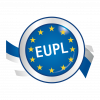This is the current, new (as from 11 august 2011) GNU organisation statement:
European Union Public License (EUPL) version 1.1
This is a free software license. By itself, it has a copyleft comparable to the GPL's, and incompatible with it. However, it gives recipients ways to relicense the work under the terms of other selected licenses, and some of those—the Eclipse Public License and the Common Public License in particular—only provide a weaker copyleft. Thus, developers can't rely on this license to provide a strong copyleft.
The EUPL allows relicensing to GPLv2, because that is listed as one of the alternative licenses that users may convert to. It also, indirectly, allows relicensing to GPL version 3, because there is a way to relicense to the CeCILL v2, and the CeCILL v2 gives a way to relicense to any version of the GNU GPL.
To do this two-step relicensing, you need to first write a piece of code which you can license under the CeCILL v2, or find a suitable module already available that way, and add it to the program. Adding that code to the EUPL-covered program provides grounds relicense it to the CeCILL v2. Then you need to write a piece of code which you can license under the GPLv3+, or find a suitable module already available that way, and add it to the program. Adding that code to the CeCILL-covered program provides grounds to relicense it to GPLv3+.
Comments:
In §2 and 3, the FSF focuses on the famous “CeCILL turnabout”. The EUPL compatibility matrix and the overview published by Rowan Wilson in OSS-Watch confirm that this turnabout is legally possible. Of course, let’s assume that there will be also a substantial functional need for doing so: if you combine with some “Hello World” trivial code, you may lose time and reputation: in the free software meritocracy, a pure “legal forking” has 0% chances to survive if it is not supported and functionally improved long term by an active and competent developers’ community.
However, the wording of §1 are still problematic (and wrong in our opinion), because providing the impression that any work covered by the EUPL can be re-licensed under Eclipse (for example, because this license is in the EUPL downstream compatibility list). The EUPL provisions are precise: It is only in case a larger derivative work is build on components covered by the Eclipse and the EUPL that this larger work (and only that one) can (possibly) be licensed “as a whole” under Eclipse. This will not change the copyleft of the covered work: it can be re-licensed alone (under EUPL), or combined in other larger works (if it is with GPL components, such larger works will be distributed under GPL).
This aspect of EUPL compatibility has been explained in a previous blog (a tenacious error about the compatibility clause)
In addition, if Eclipse may look "weaker" (than the GPLs) this does not mean that it is a "weak copyleft" license: the copyleft is strong on the source code, which ensures non-appropriation. This is the reason why analysts like the German legal centre ifrOSS classifies Eclipse as a strong copyleft license and why it was selected in the pre-EUPL study.
Therefore we would appreciate (and kindly suggest to FSF) to modify § 1 as follows (the expression “variable copyleft” is a finding of Rowan Wilson):
This is a free software license. By itself, it has a copyleft comparable to the GPL's. However, it gives recipients ways to relicense larger derivative works under the terms of another selected copyleft license (from a list) in case the work covered by the EUPL is merged with another work covered by this other license. A larger work including components covered by the Eclipse Public License or by the Common Public License could be licensed under these licenses providing copyleft on the source code only. Thus, while the copyleft is strong on the EUPL covered code and derivatives, it is variable on larger works binaries, depending on the components selected for integration.
In the above rewording of §1, we also kindly suggest to drop the remaining idea that the EUPL copyleft is incompatible with the GPLs, since §2 and §3 acknowledge that it IS legally compatible.
Therefore the next step in the right direction of a real “peace declaration” will be a rewording of §1 and moving up the EUPL in the list of GPL compatible licenses.

